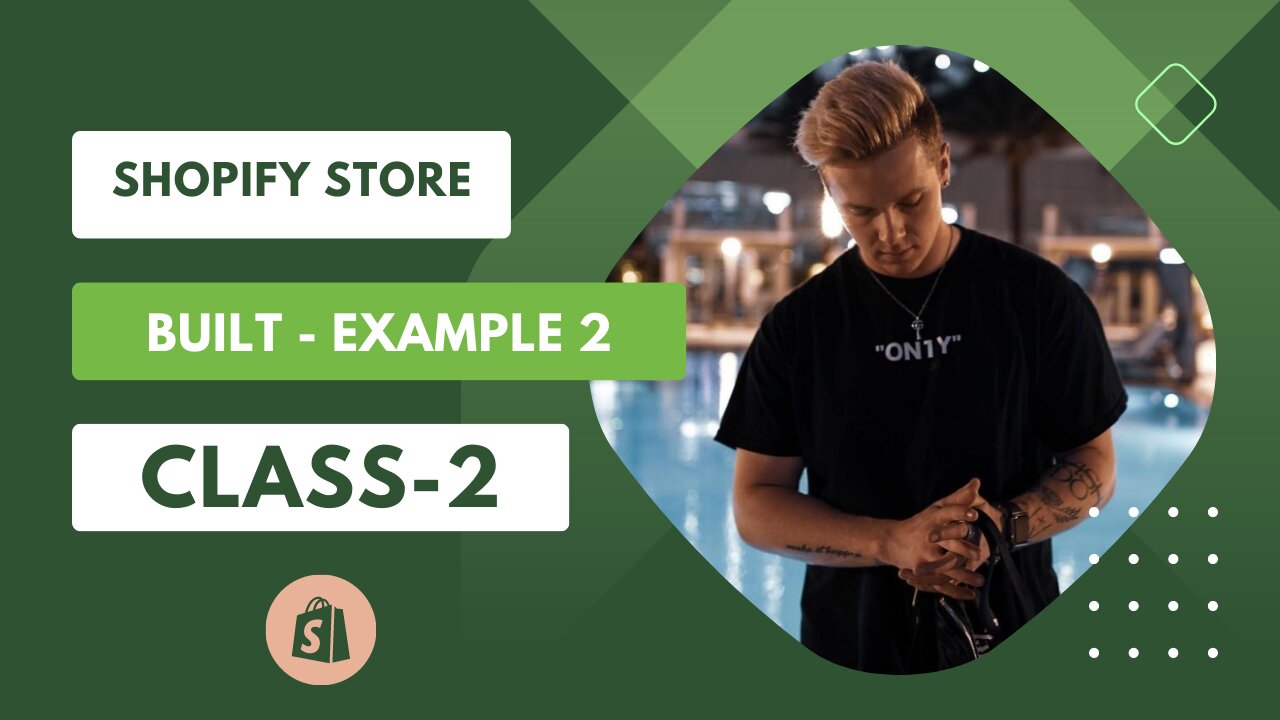Premium Only Content

Class-2 | Shopify Store Buildout (Example 2) | Learn with Fazi
Class-2 | Shopify Store Buildout (Example 2) | Learn with Fazi
Step 1: Research and Planning
Choose a Niche: Select a niche that you're passionate about and has market demand.
Keyword Research: Use tools like Google Keyword Planner, Ubersuggest, or SEMrush to identify relevant keywords for your niche.
Competitor Analysis: Study your competitors' websites to identify what keywords they are targeting and how they structure their sites.
Step 2: Setting Up Your Shopify Store
Sign Up and Choose a Plan:
Go to Shopify's website and sign up for an account.
Choose a suitable pricing plan based on your needs.
Select a Domain Name:
Choose a domain name that reflects your brand and includes relevant keywords if possible.
Pick a Shopify Theme:
Select a responsive and SEO-friendly theme from Shopify's theme store.
Step 3: On-Page SEO
Optimize Page Titles:
Include primary keywords in page titles.
Keep titles under 60 characters.
Meta Descriptions:
Write compelling meta descriptions with keywords.
Keep descriptions around 150-160 characters.
URL Structure:
Use descriptive URLs with relevant keywords.
Avoid using long strings of numbers or symbols.
Header Tags (H1, H2, H3, etc.):
Use header tags to structure your content.
Include keywords in H1 tag (main heading) and H2 tags (subheadings).
Content Creation:
Create high-quality, unique, and valuable content for your products and blog posts.
Naturally incorporate relevant keywords without keyword stuffing.
Step 4: Technical SEO
Mobile-Friendly Design:
Ensure your Shopify theme is responsive and provides a good user experience on mobile devices.
Page Speed Optimization:
Compress images and use lazy loading.
Minimize code and scripts.
Use a content delivery network (CDN) to speed up loading times.
SSL Certificate:
Enable an SSL certificate to ensure your site is secure (HTTPS).
Step 5: Image Optimization
Image Alt Text:
Add descriptive alt text to images, including relevant keywords.
Alt text improves accessibility and helps search engines understand your images.
Step 6: Off-Page SEO
Link Building:
Create valuable content that naturally attracts backlinks from other websites.
Reach out to relevant websites for guest posting opportunities.
Step 7: Google Search Console and Analytics
Set Up Google Search Console:
Submit your sitemap to Google Search Console.
Monitor for indexing errors and other issues.
Install Google Analytics:
Track website traffic, user behavior, and conversion rates.
Step 8: Social Media Integration
Social Sharing Buttons:
Add social sharing buttons to product pages and blog posts.
Create Social Media Profiles:
Set up profiles on relevant social media platforms.
Step 9: Content Marketing
Start a Blog:
Publish informative and engaging blog posts related to your niche.
Incorporate keywords naturally.
Guest Posting:
Contribute guest posts to authoritative blogs in your industry.
Remember that SEO is an ongoing process. Regularly update your content, monitor your website's performance, and adapt your strategies based on changes in the search engine algorithms and industry trends.
Tags:
Faizan Ijaz Skill,shopify,shopify tutorial,shopify tutorial for beginners,complete shopify tutorial,shopify dropshipping full course,shopify store setup,shopify store design,shopify store creation,shopify dropshipping,shopify dropshipping full course pakistan,dropshipping,dropshipping in pakistan,store setup shopify,store setup ideas
-
 1:29:29
1:29:29
Glenn Greenwald
5 hours agoWith Biden Out, U.S. Finally Admits Harms of His Israel / Gaza Policy; Biden Pays Homage To George W. Bush; Insane Women’s Tennis Scandal: An “Abusive” Coach | SYSTEM UPDATE #388
24.2K29 -
 LIVE
LIVE
Danny Polishchuk
7 hours agoWho's To Blame For LA Fires, Jewish Tunnels Update + Forbidden Anthropology
393 watching -
 1:08:10
1:08:10
Donald Trump Jr.
7 hours agoOne Week Until Inauguration, Live with Rep Anna Paulina Luna & Sen Tommy Tuberville
91.3K103 -

The StoneZONE with Roger Stone
3 hours agoLAWFARE! Are Trump's Legal Assaults Winding Down? w/ Impeachment Lawyer David Schoen | The StoneZONE
5.16K -
 1:01:43
1:01:43
Patriots With Grit
22 hours agoShocking Changes Are Coming, If You Can Believe It | John Richardson
2.26K1 -
 8:00:59
8:00:59
Dr Disrespect
10 hours ago🔴LIVE - DR DISRESPECT - MARVEL RIVALS - TOP 500 IN THE WORLD
133K27 -
 54:46
54:46
LFA TV
1 day agoThe Soon-Coming Social Millennium | TRUMPET DAILY 1.13.25 7pm
14.3K2 -
 1:00:03
1:00:03
Sarah Westall
3 hours agoWeaponized Chaos – Worst in Modern History; Changing Geopolitical Landscape w/ Andy Schectman
13.1K2 -
 LIVE
LIVE
SpartakusLIVE
3 hours ago#1 Hacker/Scammer PLUNGES into CRYPTO || !crypto !spartacoin
223 watching -
 53:15
53:15
Kimberly Guilfoyle
7 hours agoCalifornia Residents Demand Answers, Live with Rep Vince Fong, Mike Davis, and Paul Peterson | Ep. 188
50.8K58